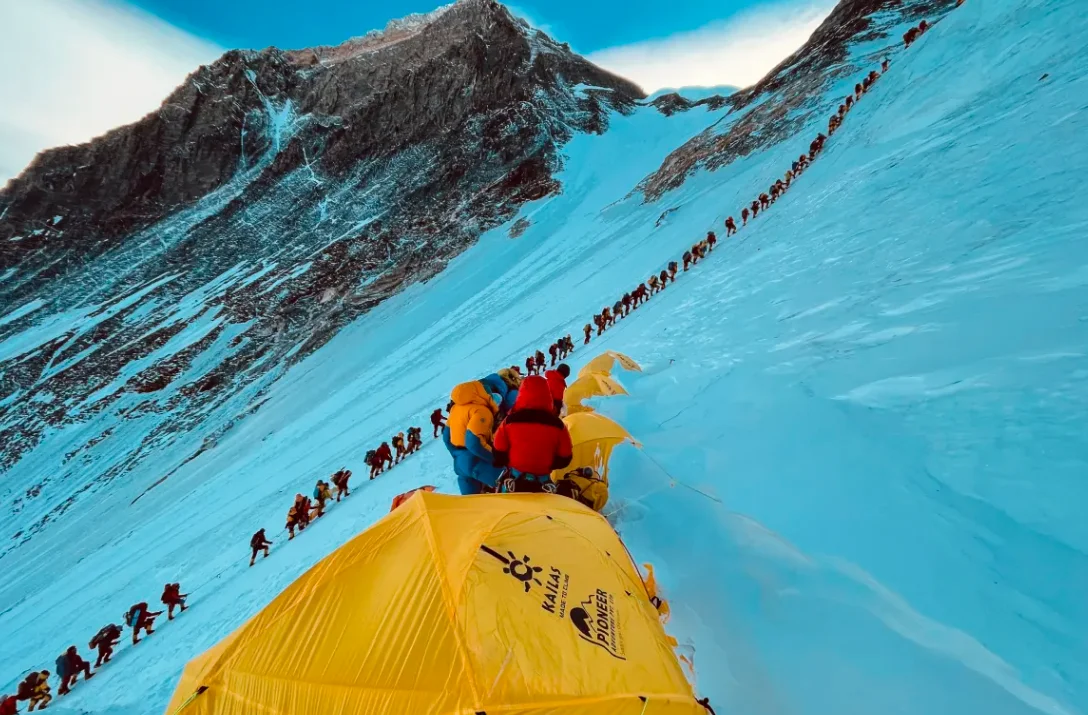
Mount Lhotse, which refers to "South Peak" (South Face), is located beneath Everest to the south, at an elevation of 8,501 meters (27,890 feet), and is only 3 kilometers away. The world's fourth tallest summit. Lhotse's south face rises 3.2 kilometers in 2.25 kilometers, making it the world's steepest face of this size. An international team climbed Mount Lhotse for the first time in 1955. During the Lhotse Expedition, one of the same team members started work on the first of a series of high-quality "Schneider maps of the Everest region." Lhotse East or Middle, Lhotse Shar, and Lhotse are the three peaks that make up the Lhotse massif. Lhotse can be ascended from either Everest Base Camp or Chhukung, which is adjacent enough.
Lhotse can be ascended from either Everest Base Camp or Chhukung, which is close by. Due to its altitude of 8,000 meters, the Lhotse Expedition faces numerous challenges, including high elevations, difficult weather conditions, and even weariness. Because the Lhotse Expedition is challenging, you can do it with the help of highly skilled mountaineers and guides.
 Hotel
Hotel
 Lunch/Dinner
Lunch/Dinner
Upon your arrive at the Tribhuvan International Airport, our representative will be there to greet you and transfer you at the hotel. You can relax and after some time stroll around the Thamel area.
 Hotel
Hotel
 Breakfast/Lunch/Dinner
Breakfast/Lunch/Dinner
You will head on a sightseeing trip of some of Kathmandu's heritage sites after breakfast. During the day, you'll finish off your excursion preparations by completing some last-minute shopping and meeting up with the expedition team and guides.
 Lodge
Lodge
 Breakfast/Lunch/Dinner
Breakfast/Lunch/Dinner
We take our early flight to Lukla (2800m), and trek to Phakding (2640m), overnight in a local lodge.
 Lodge
Lodge
 Breakfast/Lunch/Dinner
Breakfast/Lunch/Dinner
Today, trek to Namche Bazaar (3446m), overnight in a lodge.
 Lodge
Lodge
 Breakfast/Lunch/Dinner
Breakfast/Lunch/Dinner
After having food at Namche Bazar, we trek to Khumjung (3790m), overnight in a local lodge.
 Lodge
Lodge
 Breakfast/Lunch/Dinner
Breakfast/Lunch/Dinner
We rest at Khumjung for acclimatization. In the afternoon, we go around Khumjung to adapt to the local environment, overnight in a lodge.
 Lodge
Lodge
 Breakfast/Lunch/Dinner
Breakfast/Lunch/Dinner
Having food at Khumjung, we trek to Tengboche Monastery (3867m), overnight in a lodge.
 Lodge
Lodge
 Breakfast/Lunch/Dinner
Breakfast/Lunch/Dinner
From Tengboche, we trek to Dingboche (4347m), overnight in a lodge.
 Lodge
Lodge
 Breakfast/Lunch/Dinner
Breakfast/Lunch/Dinner
It is our turn to go to Lobuche (4900m), overnight in a local lodge.
 Camp
Camp
 Breakfast/Lunch/Dinner
Breakfast/Lunch/Dinner
Trek to Everest Base Camp (5357m), overnight in the camp.
 Camp
Camp
 Breakfast/Lunch/Dinner
Breakfast/Lunch/Dinner
Climbing Period.
 Camp
Camp
 Breakfast/Lunch/Dinner
Breakfast/Lunch/Dinner
Cleaning up Base Camp.
 Lodge
Lodge
 Breakfast/Lunch/Dinner
Breakfast/Lunch/Dinner
From the BC, we trek to Dingboche, overnight in a lodge.
 Lodge
Lodge
 Breakfast/Lunch/Dinner
Breakfast/Lunch/Dinner
After having lunch, we trek to Khumjung, overnight in a local lodge.
 Lodge
Lodge
 Breakfast/Lunch/Dinner
Breakfast/Lunch/Dinner
Today, we trek to Phakding, overnight in a local lodge.
 Lodge
Lodge
 Breakfast/Lunch/Dinner
Breakfast/Lunch/Dinner
After having food at Phakding, we trek to Lukla. Overnight in a lodge.
 Hotel
Hotel
 Breakfast/Lunch/Dinner
Breakfast/Lunch/Dinner
We will take morning flight from Lukla to Kathmandu earl today because we'll be in the Himalayas and can't predict how bad the weather will be. When you get in Kathmandu, you can seek relief from the agony and tiredness of trekking by visiting a spa or massage center. You'll be spending the night in a hotel.
 Hotel
Hotel
 Breakfast/Lunch/Dinner
Breakfast/Lunch/Dinner
Full day sightseeing and shopping in Kathmandu, a farewell dinner party in the evening and overnight in the hotel.
 Breakfast
Breakfast
Back to home destination.


Discover more adventures like this one, offering the same incredible experiences and destinations. Find your next journey today!
































































Mount Lhotse, which refers to "South Peak" (South Face), is located beneath Everest to the south, at an elevation of 8,501 meters (27,890 feet), and is only 3 kilometers away. The world's fourth tallest summit. Lhotse's south face rises 3.2 kilometers in 2.25 kilometers, making it the world's steepest face of this size. An international team climbed Mount Lhotse for the first time in 1955. During the Lhotse Expedition, one of the same team members started work on the first of a series of high-quality "Schneider maps of the Everest region." Lhotse East or Middle, Lhotse Shar, and Lhotse are the three peaks that make up the Lhotse massif. Lhotse can be ascended from either Everest Base Camp or Chhukung, which is adjacent enough.
Lhotse can be ascended from either Everest Base Camp or Chhukung, which is close by. Due to its altitude of 8,000 meters, the Lhotse Expedition faces numerous challenges, including high elevations, difficult weather conditions, and even weariness. Because the Lhotse Expedition is challenging, you can do it with the help of highly skilled mountaineers and guides.
Upon your arrive at the Tribhuvan International Airport, our representative will be there to greet you and transfer you at the hotel. You can relax and after some time stroll around the Thamel area.
You will head on a sightseeing trip of some of Kathmandu's heritage sites after breakfast. During the day, you'll finish off your excursion preparations by completing some last-minute shopping and meeting up with the expedition team and guides.
We take our early flight to Lukla (2800m), and trek to Phakding (2640m), overnight in a local lodge.
Today, trek to Namche Bazaar (3446m), overnight in a lodge.
After having food at Namche Bazar, we trek to Khumjung (3790m), overnight in a local lodge.
We rest at Khumjung for acclimatization. In the afternoon, we go around Khumjung to adapt to the local environment, overnight in a lodge.
Having food at Khumjung, we trek to Tengboche Monastery (3867m), overnight in a lodge.
From Tengboche, we trek to Dingboche (4347m), overnight in a lodge.
It is our turn to go to Lobuche (4900m), overnight in a local lodge.
Trek to Everest Base Camp (5357m), overnight in the camp.
Climbing Period.
Cleaning up Base Camp.
From the BC, we trek to Dingboche, overnight in a lodge.
After having lunch, we trek to Khumjung, overnight in a local lodge.
Today, we trek to Phakding, overnight in a local lodge.
After having food at Phakding, we trek to Lukla. Overnight in a lodge.
We will take morning flight from Lukla to Kathmandu earl today because we'll be in the Himalayas and can't predict how bad the weather will be. When you get in Kathmandu, you can seek relief from the agony and tiredness of trekking by visiting a spa or massage center. You'll be spending the night in a hotel.
Full day sightseeing and shopping in Kathmandu, a farewell dinner party in the evening and overnight in the hotel.
Back to home destination.
© 2011 - 2022 All rights reserved. Mountain Delights Treks and Expedition Pvt. Ltd. Developed By : Xenatech Nepal